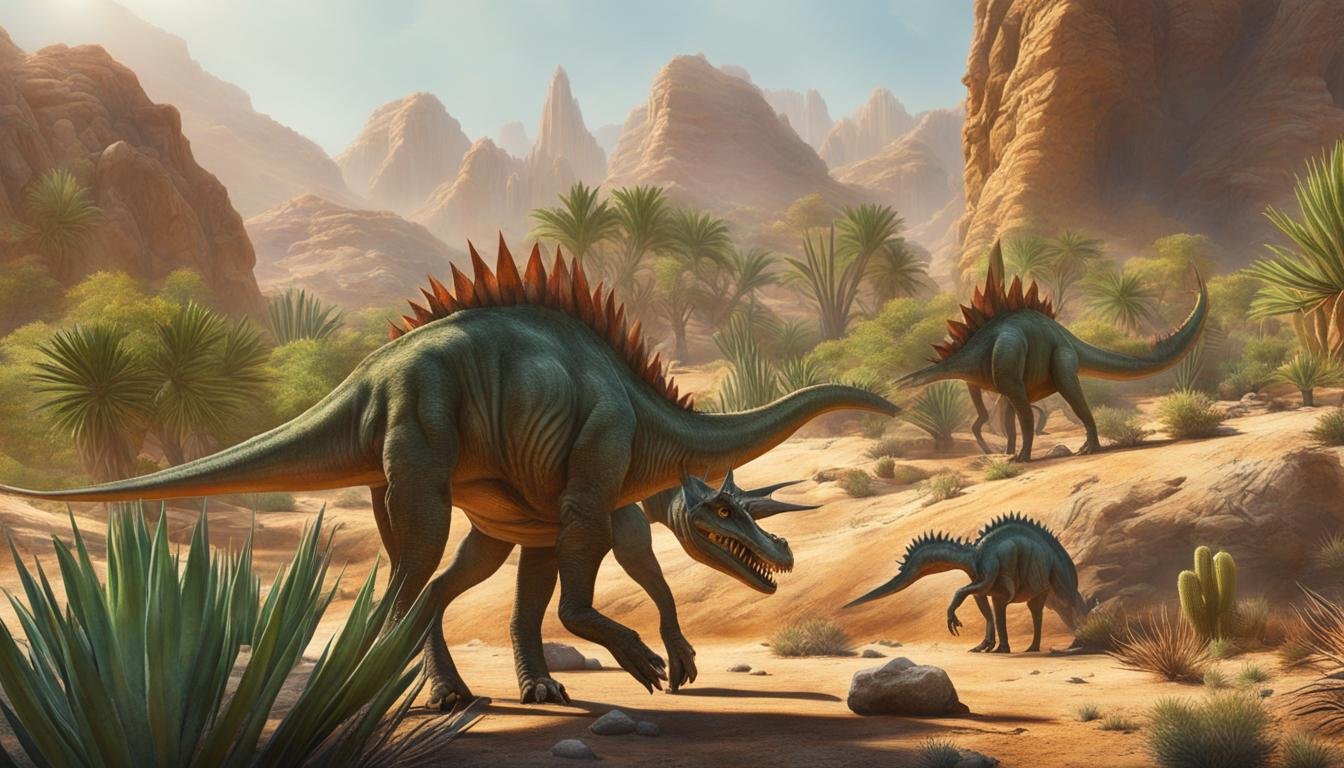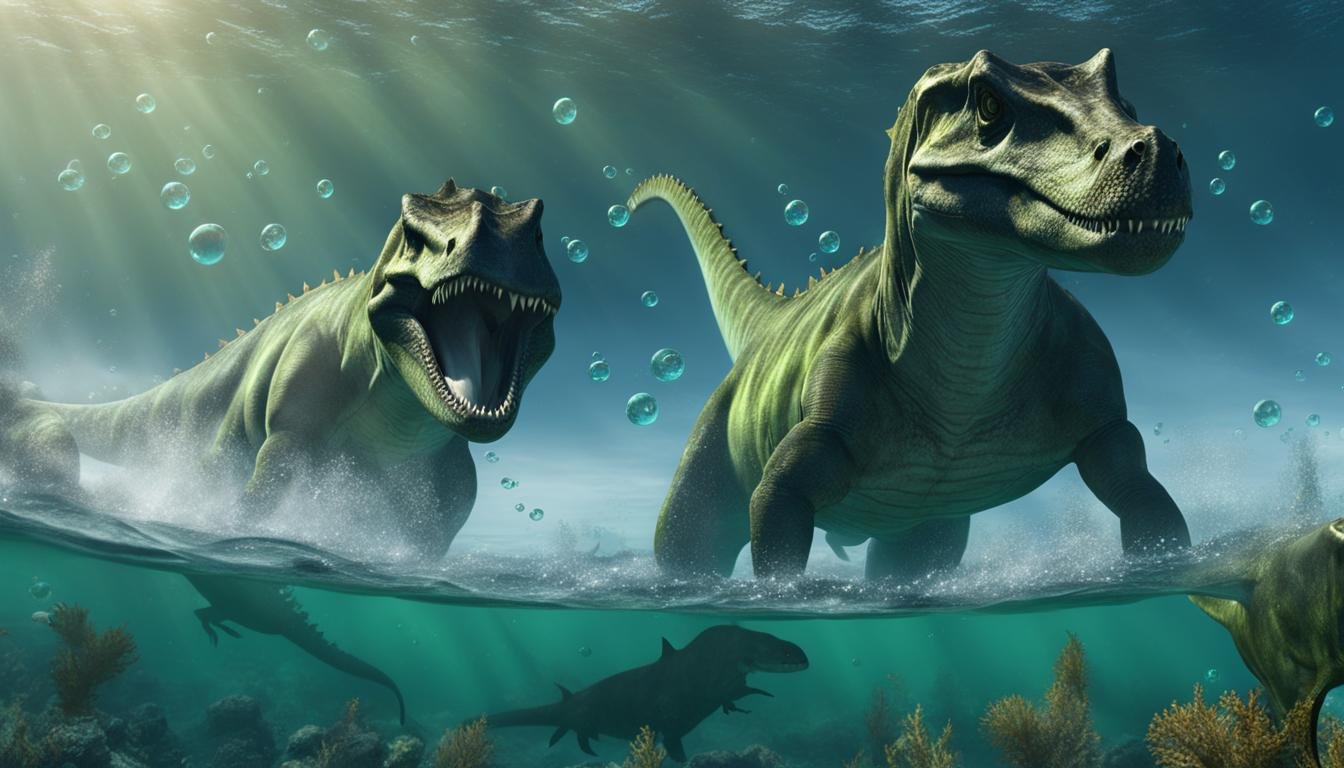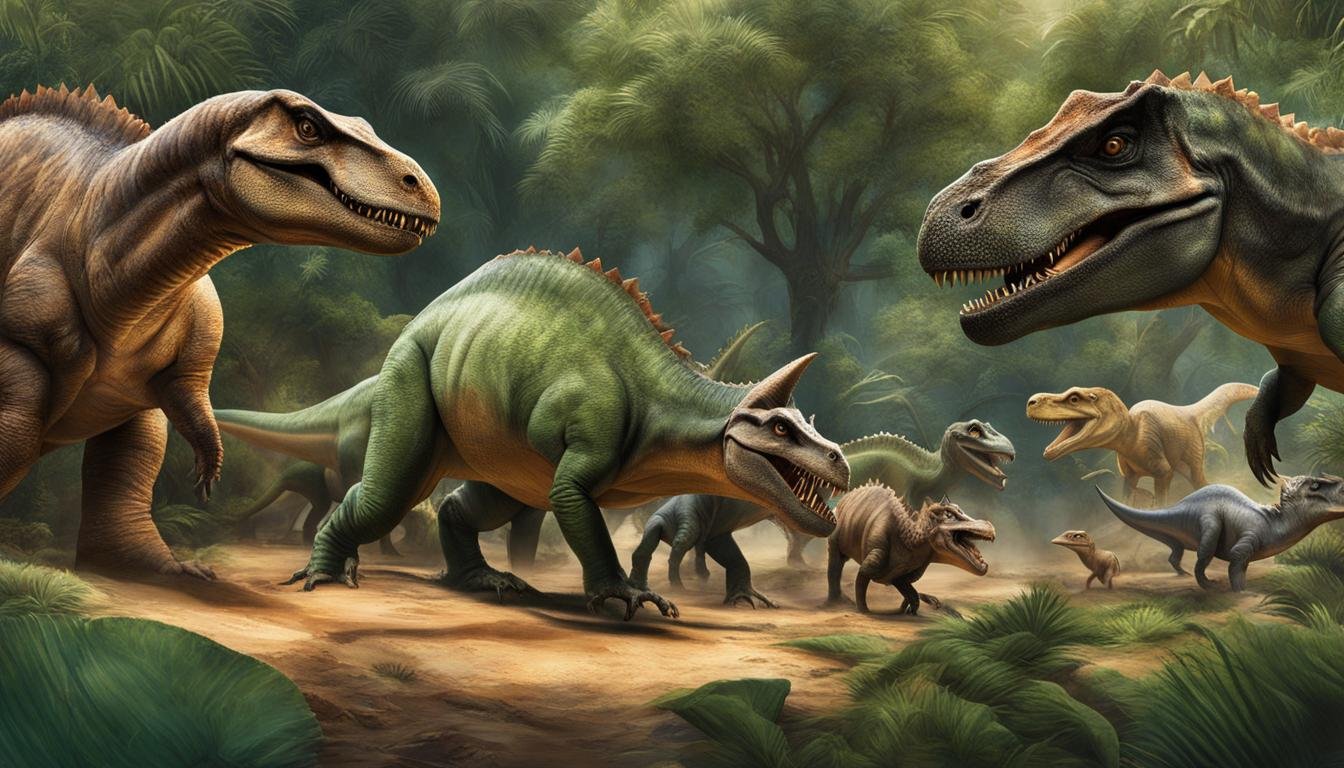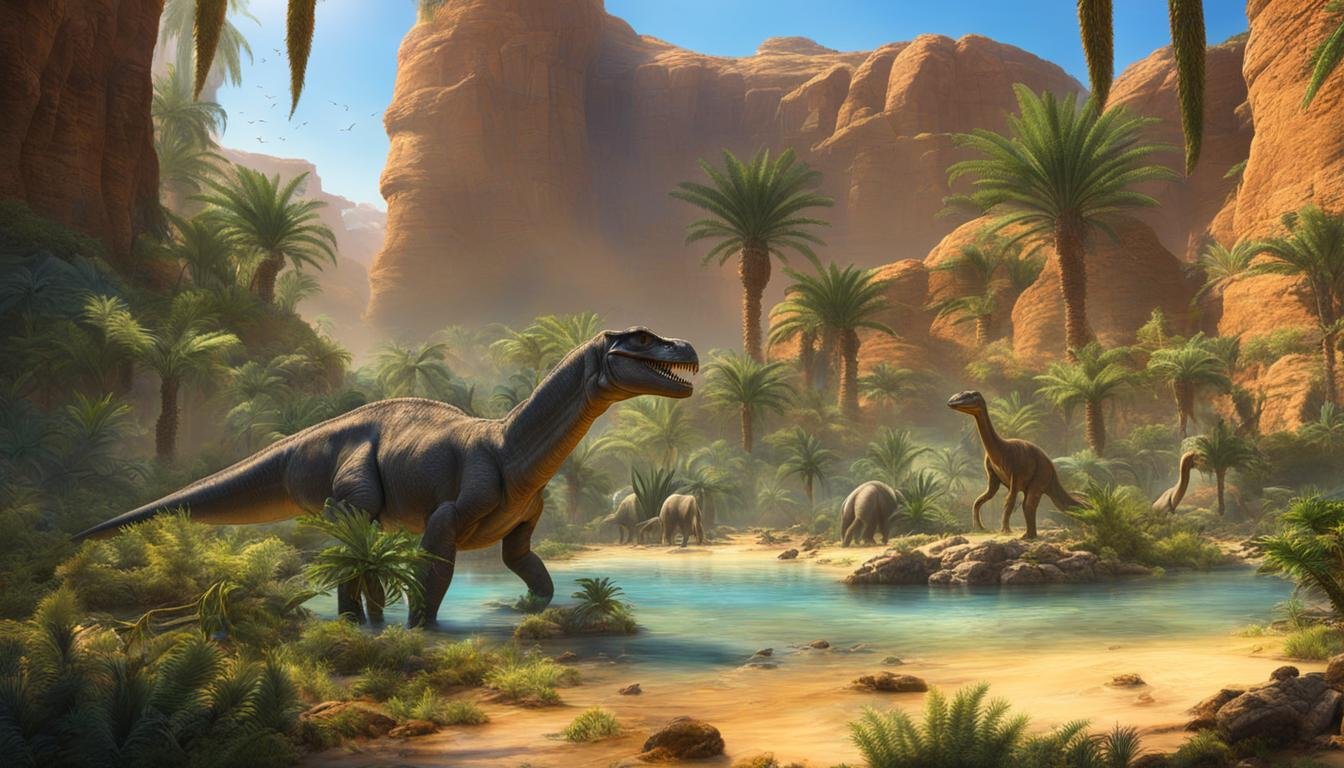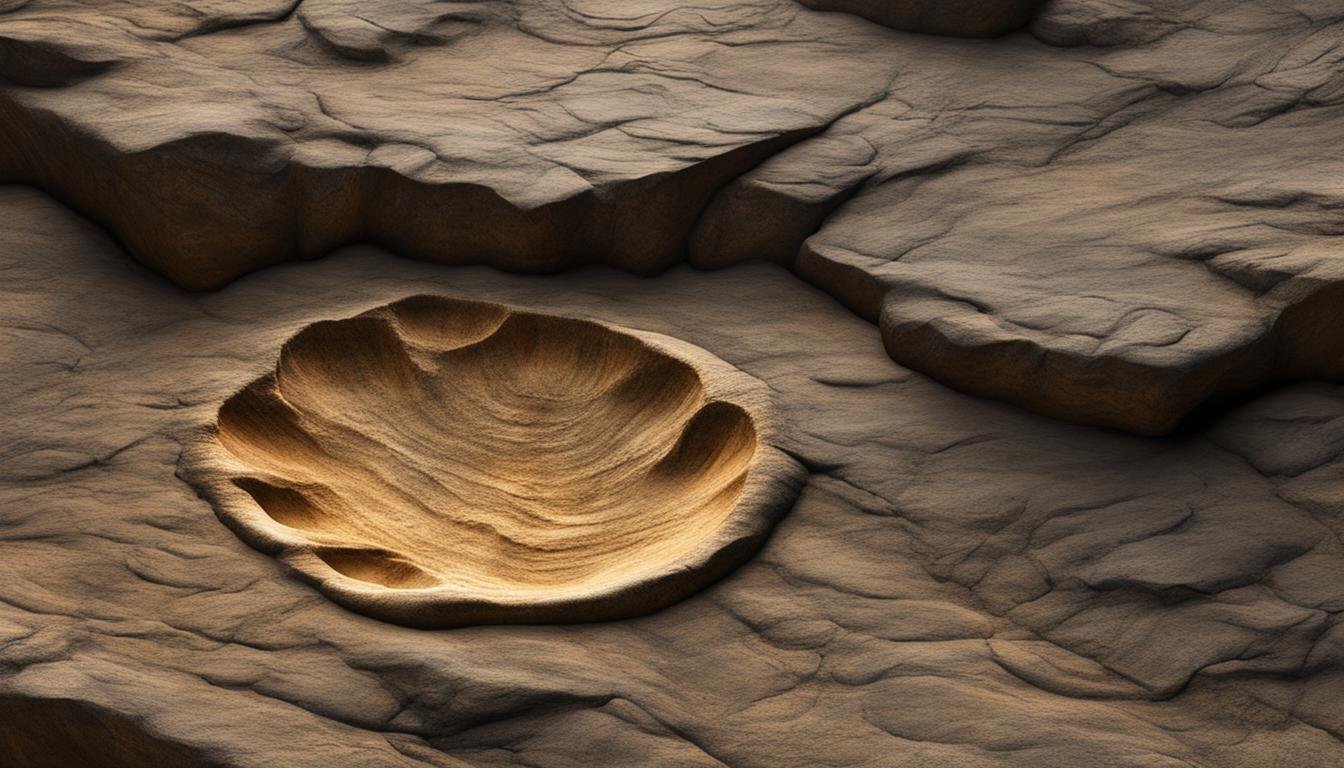Dinosaurs, those magnificent prehistoric creatures, once roamed the deserts of our planet. These arid landscapes, considered hostile to life, were home to a diverse array of dinosaur species during the Jurassic and Cretaceous periods. Studying desert dinosaurs provides us with invaluable insights into the ancient world – their adaptations, the climatic patterns of the past, and the intricate interplay of ecosystems.
Exploring these deserts, paleontologists have unearthed fossilized remains that shed light on the existence of these remarkable creatures. These fossils, preserved over time due to desertification, provide us with a treasure trove of information about the unique species that once inhabited these barren landscapes.
| Key Takeaways | Description |
|---|---|
| Desert Dinosaurs’ Survival | Dinosaurs thrived in the arid conditions of the Jurassic and Cretaceous periods, adapting to desert environments. |
| Insights into Past Climates | Research on desert dinosaurs provides understanding of ancient climatic patterns and ecosystem dynamics. |
| Fossilized Remains in Deserts | Fossils found in desert regions offer valuable insights into unique dinosaur species that once existed. |
| Desertification and Fossil Preservation | The process of desertification over time has helped preserve vital fossil records, facilitating scientific discoveries. |
| Resilience and Adaptability | Studying desert dinosaurs highlights the resilience and adaptability of these ancient creatures in challenging environments. |
Dinosaurs in the Desert: A Historical Perspective
During the Jurassic period, while dinosaurs roamed rainforests and wet tropics, desert regions were also home to a variety of prehistoric creatures. One such area was the Western US, which, at the time, was a coastal desert. Fossilized dinosaur tracks discovered in these desert regions provide valuable insights into the lives of dinosaurs in arid environments.
“The desert regions of the Western US were once inhabited by a diverse range of dinosaurs,” says Dr. Emily Sanders, a paleontologist specializing in desert dinosaur research. “We have found tracks of both carnivorous and herbivorous dinosaurs, which suggest that these animals adapted to the desert conditions and possibly migrated to areas with more vegetation.”
Dinosaur tracks found in the desert regions of the Western US reveal the presence of carnivorous dinosaurs like Allosaurs, Troodons, and Dromaeosaurs. These powerful predators coexisted with herbivorous dinosaurs such as sauropods and hadrosaurs, suggesting a complex ecosystem even in the harsh desert environment.
The discoveries of desert dinosaur tracks and fossils have led researchers to believe that the evolution of desert-adapted dinosaurs occurred during the Jurassic and Cretaceous periods. Species like Ouranosaurus and Archaeoceratops, with their unique adaptations, thrived in the arid desert conditions.
Table: Desert Dinosaur Discoveries
| Dinosaur Species | Location | Key Findings |
|---|---|---|
| Allosaurs | Western US | Large carnivorous dinosaurs adapted to desert environments |
| Troodons | Western US | Small, intelligent dinosaurs with excellent night vision |
| Dromaeosaurs | Western US | Raptor-like dinosaurs known for their sharp claws |
| Sauropods | Western US | Long-necked, herbivorous dinosaurs capable of reaching massive sizes |
| Hadrosaurs | Western US | Duck-billed dinosaurs that migrated in search of vegetation |
| Ouranosaurus | Niger | Desert-adapted dinosaur with a sail-like structure on its back |
| Archaeoceratops | China | Small horned dinosaur believed to have lived in desert regions |
As the study of desert dinosaurs continues, scientists hope to uncover more secrets about their adaptations and behavior in arid environments. Their findings shed light on how these remarkable creatures not only survived but thrived in the desert millions of years ago.
Dinosaurs Adapted to Desert Environments
The harsh arid conditions of the desert presented numerous challenges for dinosaurs, but these prehistoric creatures displayed remarkable adaptations to survive and thrive in these extreme environments. Ancient desert-dwelling dinosaurs demonstrate the incredible diversity and resilience of life during the Mesozoic Era.
Unique Adaptations for Survival
One example of a dinosaur that adapted to desert conditions is the Spinosaurus. This large carnivorous dinosaur possessed a sail-like structure on its back, which could have served multiple purposes. Some scientists speculate that the sail may have helped regulate body temperature, providing a cooling mechanism in the scorching desert heat. Others believe it could have been used for display or species recognition. Additionally, the Spinosaurus had long, narrow jaws with conical teeth, suggesting a specialized diet that may have included fish or other aquatic prey found in desert oases and rivers.
Another fascinating desert-dwelling dinosaur is the Archaeoceratops. This small herbivorous dinosaur had a beak-like structure and powerful jaws, enabling it to efficiently feed on tough desert vegetation. Its frilled head likely served various functions, including communication and defense against predators.
The Ecological Role of Desert-Dwelling Dinosaurs
Studying desert-adapted dinosaurs provides valuable insights into their interplay with the surrounding ecosystem. These dinosaurs were part of a complex web of interactions, showcasing the remarkable adaptability of species to the unique challenges posed by desert environments. By examining the fossilized remains and trackways left behind by these ancient creatures, scientists gain a deeper understanding of the ecological fabric of their coexistence.
| Dinosaur | Adaptation |
|---|---|
| Spinosaurus | Sail-like structure for thermoregulation |
| Archaeoceratops | Beak-like structure and frilled head for feeding and defense |
| Ornithomimid | Long legs for greater mobility in search of scarce resources |
| Cycleosaurus | Broad, flat body for efficient heat dissipation |
As we continue to unearth and study the fossils of desert-dwelling dinosaurs, our understanding of their adaptations and the ecological significance of these ancient creatures grows. These remarkable adaptations highlight the incredible diversity of life in the desert and emphasize the intricate relationship between species and their environments.
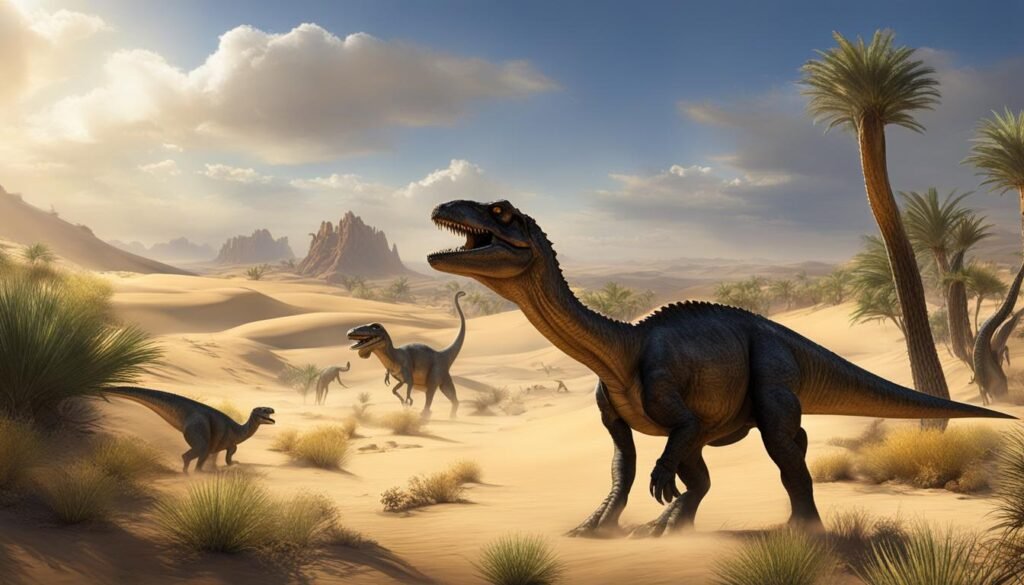
Life in the Desert: Adaptations of Amphibians and Reptiles
The harsh desert environment has forced amphibians and reptiles to develop remarkable adaptations to survive. While amphibians tend to live near permanent water sources or burrow deep to avoid extreme aridity, reptiles have evolved a range of characteristics that allow them to thrive in drier habitats. One of the most significant advantages reptiles have is their waterproof skin, which minimizes water loss through evaporation.
Desert reptiles have also developed various mechanisms for thermoregulation, enabling them to withstand extreme temperatures. Many reptiles, such as desert iguanas and sidewinder snakes, have evolved heat-reflecting scales, which help keep them cool during scorching days. Additionally, they have specialized behaviors, such as basking in the sun to warm up, or seeking shade and burrows to cool down.
Unlike amphibians, reptiles lay amniotic eggs, which are protected by a waterproof shell. This adaptation allows reptiles to reproduce in arid environments where water is scarce. Female reptiles carefully choose nesting sites with optimal conditions, such as sandy areas that retain moisture and offer protection against predators. The eggs are designed to withstand long periods of drought, ensuring the survival of their offspring in the harsh desert conditions.
| Adaptation | Example |
|---|---|
| Water storage | Camels store water in their humps, allowing them to survive without drinking for extended periods. |
| Thermoregulation | Desert iguanas have heat-reflecting scales and bask in the sun to warm up or seek shade to cool down. |
| Burrowing | Sidewinder snakes bury themselves in sand to escape extreme temperatures and conserve moisture. |
| Waterproof skin | Reptiles have waterproof skin to minimize water loss through evaporation. |
Amphibians, on the other hand, have adapted to desert environments in different ways. Some amphibians, like the spadefoot toad, undergo aestivation—a dormant state similar to hibernation—during periods of extreme heat or drought. They bury themselves deep in the ground and wait for rain to revive them.
In summary, desert-adapted amphibians and reptiles have evolved a range of remarkable traits and behaviors that allow them to thrive in arid conditions. These adaptations include water storage, thermoregulation, burrowing, and waterproof skin. By understanding the survival strategies of these ancient desert-dwelling reptiles and amphibians, we gain insight into the incredible resilience of life in the desert.
The Impact of Climate on Desert-Dwelling Dinosaurs
Desert climate played a crucial role in shaping the evolution and survival strategies of desert-dwelling dinosaurs during the Mesozoic Era. The Jurassic Period, characterized by warm and wet conditions, provided the perfect environment for lush vegetation and diverse dinosaur species to thrive. This period witnessed the emergence of iconic dinosaurs like the Allosaurs, Troodons, and Dromaeosaurs in desert regions such as the Western US, which was a coastal desert at the time.
The arid and extreme climate in desert regions posed challenges for dinosaurs, influencing the distribution and diversity of species. Large herbivorous dinosaurs struggled to find sufficient vegetation in the desert environment, leading to the dominance of smaller, more adaptable carnivorous dinosaurs. This shift in the dinosaur community resulted from the scarcity of resources and the need to survive in an arid landscape.
Furthermore, the fluctuations between periods of drought and intense heat had a significant impact on desert ecosystems, affecting the survival and adaptation of desert-dwelling dinosaurs. The extreme climate conditions forced these dinosaurs to develop specific physiological and behavioral traits to cope with limited water availability and high temperatures. These adaptive mechanisms included efficient thermoregulation, water storage abilities, and behavioral adaptations like burrowing to escape extreme heat.
The Influence of Climate on Desert-Dwelling Dinosaurs
“The desert climate served as a driving force in shaping the morphology and behavior of desert dinosaurs. They had to adapt to the harsh conditions, and as a result, we see unique dinosaur species with specialized features that allowed them to thrive in desert regions.” – Dr. Jane Simmons, Paleontologist
Studying the impact of climate on desert-dwelling dinosaurs provides valuable insights into the ecological dynamics of ancient desert ecosystems. It helps us understand the relationship between climate change and dinosaur evolution, highlighting the remarkable resilience of these extinct creatures in extreme environments. By uncovering and analyzing fossil records, paleontologists continue to discover new information about the fascinating world of desert dinosaurs and their ability to adapt and survive against all odds.
| Dinosaur Species | Adaptive Features | Habitat |
|---|---|---|
| Spinosaurus | – Long, narrow snout for catching fish and small prey – Sail-like structure on its back for thermoregulation – Strong limbs for swimming and walking in the desert | North African deserts |
| Archaeoceratops | – Beak-like mouth for feeding on tough desert plants – Compact size for efficient water and energy usage – Camouflaging coloration | Mongolian deserts |
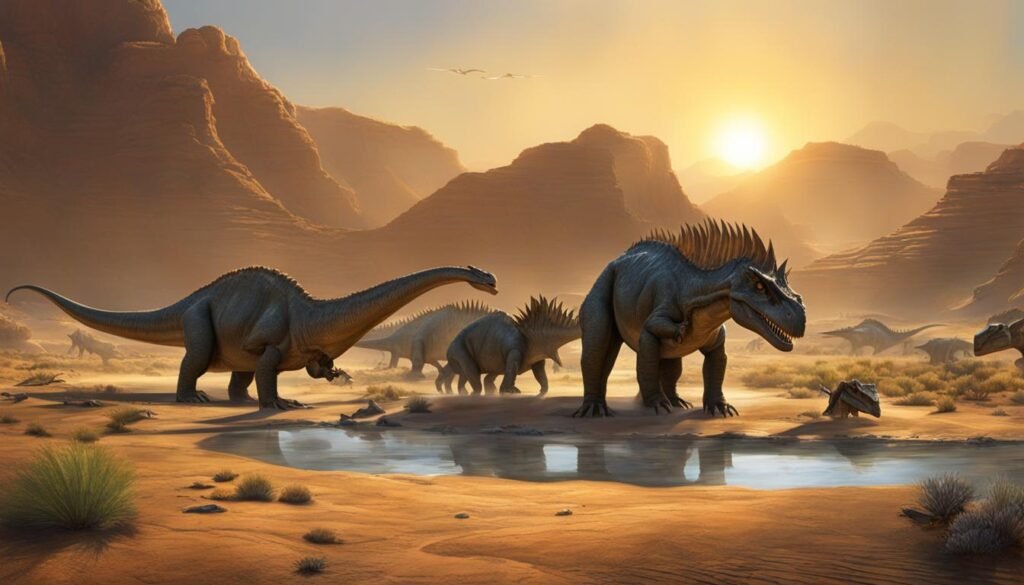
Conclusion
Desert dinosaurs and ancient desert-dwelling reptiles were remarkable examples of adaptation to survive in harsh arid conditions. These prehistoric creatures provide valuable insights into the complex ecological dynamics of ancient desert ecosystems. Through the study of desert-adapted dinosaurs and their reptilian counterparts, we gain a deeper understanding of how climate shaped dinosaur evolution and the resilience of species in extreme environments.
From the fossil records and research, we continue to uncover the fascinating world of desert dinosaurs and their unique survival strategies in arid habitats. These ancient reptiles, with their ability to withstand the extreme challenges of desert life, offer us a window into the past and help us appreciate the tenacity of life in the harshest of conditions.
The impact of climate on desert-dwelling dinosaurs is evident in the diversification and distribution of species. The warm and wet conditions of the Jurassic Period allowed for the development of lush vegetation, supporting a diverse range of dinosaur species. However, the arid and extreme climate in deserts limited the distribution and diversity of dinosaurs, favoring smaller carnivorous dinosaurs over their larger herbivorous counterparts.
By studying these desert dwellers, both dinosaurs and reptiles, we gain a deeper understanding of the interplay between climate and evolutionary processes. The ancient desert-dwelling reptiles, in particular, showcase remarkable adaptations that allowed them to survive and thrive in desert environments. As we continue to make new discoveries and conduct further research, the story of desert dinosaurs and their reptilian counterparts unfolds, revealing the extraordinary resilience of life in the face of extreme conditions.

